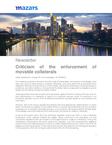
Criticism of the enforcement of movable collaterals
The collateral contracts enshrined in the Civil Code of Andrés Bello, among which is the pledge, have been very useful to allow access to credit by individuals, since they allow them to guarantee those obligations that they contract with any of their assets, granting the beneficiary of these guarantees a preference over other creditors in the event that the debtor fails to comply with its obligations and its assets are not sufficient to pay the totality of these.
These guarantees have also sought to promote greater agility at the time of being enforced, since for their effectiveness it is necessary to resort to an execution process, which is conceived in our procedural regulation as one of the jurisdictional processes of greater speed for its processing and culmination.
However, due to the various operational problems that have plagued the Judicial Branch in recent years, including the congestion of the judicial offices, it has been generated that even the execution processes are of a lengthy and lengthy process, a circumstance that causes that the intended agility of the pledges cannot be achieved, thus slowing down the access to credit by individuals.
It was for this reason that in 2013 the Colombian legislator issued Law 1676, or Law of Movable Guarantees, which radically modified the pledge regime enshrined in the Colombian civil and commercial regulations (this law sought to encourage access to credit for individuals). Among the modifications introduced by this law to achieve this objective, Law 1676 introduced two additional mechanisms to the judicial process to enforce a chattel collateral (generic term used in Law 1676 for pledges and other guarantees). These mechanisms are the direct payment and the special execution of the guarantee, which do not require judicial intervention for their processing.
Direct payment consists of a mechanism that allows the creditor to keep the property directly without the need to resort to any third party for such purpose. This mechanism is regulated in Article 60 of Law 1676 and in order to be applicable, the rule requires that this mechanism be expressly agreed in the guarantee contract that may be executed, or in the event that the creditor has the material possession of the property given as guarantee. In addition, in the event that the value of the collateral exceeds the amount of the secured obligation, the creditor must pay the defaulting debtor the difference between the two values.
On the other hand, the special enforcement of the collateral allows the parties to the collateral contract to establish the procedure to enforce the collateral granted, provided that such procedure complies with the requirements set forth in the law.
These two mechanisms have in common that once the creditor of a chattel collateral wishes to enforce it, it must go to an expert appraiser to determine the value of the property subject of the collateral and thus be certain of the amount of the obligation extinguished with the collateral granted.
In view of this requirement for the procedure for the enforcement of movable collateral, a criticism must be made regarding the moment of determination of the value of the property given as collateral, since this requirement reduces the speed of these procedures, in addition to increasing their costs, thus undermining the agility intended at the time of issuance of this rule.
This is why the legislator should have allowed the parties to determine the value of the collateral from the moment of the execution of the respective contract of guarantee, eliminating the need for the intervention of the appraiser, thus reducing time and costs to these two enforcement procedures, conceived as the most agile in this regulation.
Thus, although Law 1676 will be in force for only six years, a modification is necessary in relation to the intervention of experts in its enforcement mechanisms, establishing instead an appraisal made by the parties themselves, thus reducing the time and costs of the enforcement of the guarantees granted.


